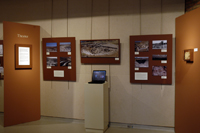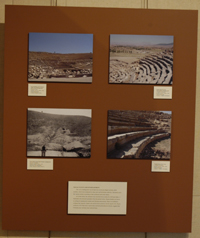
Duderstadt Gallery: Section 6 - Theater
As the city of Antioch flourished, so too did its theater. Built during the Hellenistic period or the late Roman Republic, the theater was subsequently modified throughout the Roman imperial period. The various alterations to the theater reflected the changing forms of entertainment, religious beliefs, and levels of economic prosperity of the city’s residents during much of Antioch’s history.
The seating area (cavea) of the theater could accommodate several thousand spectators to watch various types of performances in the horseshoe-shaped orchestra and on the stage. Tragedies, comedies, rituals, political gatherings, beast fights, and perhaps even martyrdom all took place here at different times.
The theater was situated alongside the heavily traversed, shop-lined Decumanus Maximus, the main east-west route between the City Gate and the Imperial Cult Sanctuary. It is uncertain whether the open square area adjoining the theater on the west was once a colonnaded portico lined with commercial establishments. Such squares are found at theaters elsewhere in the Roman Empire.
The excavation of the theater is a recent undertaking by Turkish archaeologists that started in 1991 and continued intermittently until 2004. In 1924 George Swain and others took photographs of the hillside against which the cavea was built and the adjacent area.



